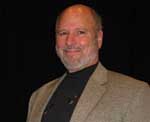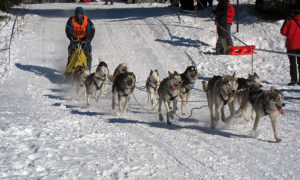By Jerry Klinger

BOYNTON BEACH, Florida — Alaska is the land of the very long day and the land of the very long, longer, night. During the very long day temperatures can soar to 100 degrees. During the very long nights, temperatures can drop to 50 degrees below zero plus.
Alaskan Jews wittily refer to themselves as the “frozen chosen.”
Most denizens of the lower 48, as Alaskans like to refer to us warmer clime preferring types, do not know Alaska has a Jewish story as old as northern recorded history.
Did Jews invent the Baked Alaska, Klondike Bars, or Eskimo Pies? Honestly…no.
Alaska was first spotted by Western eyes in 1741. Danish cartographer, Vitus Jonassen Bering, commanding a Russian Naval expedition, spotted land.
His discovery was poorly timed. He and 28 of his 34-member crew died from hunger, scurvy, and the horrific weather of the northern seas as winter set in. Bering’s honor was being interred on an island named for him, Bering Island. His honors extended further, the Bering Strait, the Bering Sea, the Bering Glacier, and the Bering Land Bridge and more.

So what does Bering’s story have to do with Jewish history? Bering knew the north gets cold. He brought along a few Jews as furriers. Their proper names are long lost to a certain memory. Sam “the Shtreimel” Cohen is reputed to have been on board. Others say it was a guy named Bergdorf or his cousin Goodman.
Furs were big business in the exploration and exploitation of America. Fur trappers, European and Native Americans alike, over-harvested to near extinction fur-bearing animals.
The Russians claimed all of Alaska for themselves without a howdy-do to the few locals they could find. Native tribes understood taking territory. They did it amongst themselves for control of resources.
The Czar “granted” a new enterprise, a monopoly, the Russian American Company. The company sent employees, “promyshlenniki,” fur traders, trappers, and businessmen to Alaska to develop their investment. Nikolay Yakovlevich Rosenberg was one of the Alaskan managers of the company from 1850-1853.
Rosenberg was predated by Alexander Cohen and his family, who settled in Sitka in 1848. Sitka was the “Capitol” of Russian Alaska. The Cohens were followed by other German Jews seeking opportunity. Sitka was transformed from a tent city to a real city with real businesses centered upon natural resources, trading and “Cat Houses.”
Furs and fur trading were the big draw, but the Russians were losing business to a more aggressive fur trading outfit, the British Hudson Bay Company.
A San Francisco fur trader, Louis Goldstone, yes, a tribal member, got wind that the Russian-American Company wanted to sell their interests in Alaska. For that matter, the Russian government, needing money badly, wanted to sell all of Alaska but not to the British. The Russians had a thing about the British from the Crimean War. The British had kicked the Russians’ butts. The Russians preferred an American syndicate or, better yet, to America.
Goldstone engaged former California U.S. Senator Cornelius Cole, working as a lobbyist in Washington, to start the ball rolling. Cole was childhood buddies with U.S. Secretary of State William Seward. The old pals got together.
Connections…connections.
Seward negotiated with the Russians to buy all of Alaska for less than $.02 an acre or $7.2 million dollars. The press called it “Seward’s Folly.” It was not the first of the last time the press got it wrong.
The deal was signed March 1867.
If the Jews had caused the purchase of Alaska for $7.2 million dollars, the United States, they did very well for the U.S. No one understood at the time what treasures of gold, oil, and other natural resources were in Alaska.
As the ink dried on the paper, two wealthy San Francisco Jewish fur traders, Lewis Gerstle and Louis Sloss, purchased all the concessions of the Russian-American Company.
Their new company was called the American Commercial Company. Gerstle and Sloss never went to Alaska. It was too cold. They had employees they could send instead.
The Russian flag was officially hauled down Oct. 1, 1867. The American flag was run up on the flagpole on Sitkas’ Castle Hill by the U.S. Army. The soldier ordered to haul down the Russian Flag and raise the Stars and Stripes was a tribal member, Benjamin Levy.
American ownership of Alaska continued to attract the tough, the courageous, and those willing to take chances. Jews were certainly there. Just one year after the transfer from Russian control to American, Emil Teichman described in his diary a strange site, Jews gathering for Friday night services in a Sitka Warehouse.
Alaska plugged along slowly until the discovery of gold broke the damn loose. The first gold rush – was the Klondike Goldrush of 1896. It was tiny in comparison to the Nome Gold Rush of 1899 that attracted the likes of Wyatt Earp and his common-law Jewish wife Josephine Marcus. They mined the miners, opening a saloon and hotel.
Things did not turn out well for Wyatt and Josephine in Nome. They returned to San Francisco. He died in 1929. She passed in 1944. They are resting in the Jewish cemetery in Colma, California.
Three “Lucky Swedes,” Jafet Lindeberg, Erik Lindblom, and John Brynteson, were almost literally strolling along the beach in Nome when they bent over and found gold glittering at them in the sands. In the flash of an eyelid, Nome had a population of 10,000 by the winter of 1899.
Jews caught the gold fever too. Nineteen-year-old Emil Hirschberg heard about gold on the beaches of Nome for the taking. Perhaps not playing with a full deck, it was March in Dawson Canadian Yukon, the temperature was minus 30 degrees, Herschberg headed to Nome on a bicycle.
He made it, all 1,100 miles, across wilderness, frozen rivers, through blinding snowstorms, and worse to try his luck at gold plucking. For Herschberg, like for most gold seekers, the easy gold was gone.
Some gold-rushers stayed, most did not. Those who stayed are a particularly hardy breed. Some Jews remained, most returned. The Jews who remained became instrumental in the development of Alaskan cities such as Fairbanks. Abe Spring was an early Fairbanks Jewish resident. In 1906, he proposed that Alaska become a refuge for Jews from viciously anti-Semitic Russia. The first mayor of Anchorage was Jewish businessman, philanthropist, and humanitarian, Leopold David.
Jews were part and parcel, though small in number, represented in every aspect of Alaskan life from fishing, mining, retail, government, science, and more.
My only venture to Alaska was to Seward Alaska. I interviewed Captain Jack Johnson, a volunteer crew member on the famed Holocaust Rescue ship the S.S. Exodus. The Exodus was nicknamed by Jewish newspaper-woman Ruth Gruber, the Ship that launched a Nation, the nation of Israel.
On a darker note, Alaska had been proposed a second time as a haven for Jews escaping antisemitism. In 1938, Harold Ickes, the secretary of the interior, proposed bringing in 10,000 plus Jewish refugees from the horrors of Germany after Kristallnacht. A full report was generated and presented to President Franklin Delano Roosevelt. Alaskan Territorial Governor Ernst Gruening, a Roosevelt appointee, was Jewish.
Gruening recommended against making Alaska a home of rescue to escaping Jews from Germany. Alaskan antisemitism was a very real thing. Roosevelt did not want his political capital to be damaged. The Alaskan Holocaust rescue dream was killed along with untold Jewish victims.
When Alaska became the 49th state, Gruening became one of the two first senators. He became a very strong supporter of Israel.
Antisemitism is not a big factor in contemporary Alaska though it does exist. Jews are well integrated into Alaskan life from the Lubavitch in Anchorage to the first Jewish woman to have successfully completed the most grueling physical experiences of Alaskan life, racing in the historic Iditarod, 1,100 miles mushing a dog sled team from Anchorage to Nome, Susan Cantor.
Recently, Jews made up ten percent of Alaska’s elected state Legislature.
However, the reality of antisemitism is increasingly real, certainly in the lower 48.
The Jewish American Society for Historic Preservation (JASHP) has completed projects in 40 states and in six countries reflecting on Jewish American commonality and legitimacy.
The usual response about a “discovered” JASHP marker is, “I did not know that.”
JASHP has offered to the Jewish communities of Anchorage, Sitka, and to Nome Jewish historic interpretive markers reflecting Alaska’s diversity and inclusivity, the incredible American experiment.
Will the offer be taken? Don’t know for now.
*
Jerry Klinger is president of the Jewish American Society for Historic Preservation, www.JASHP.org.
Jack Withington Poor choice of words
In the Korean Wat, the casualties over 10,000 at the deadly battle at the Chosin Reservoir .
Very interesting! Thank you.